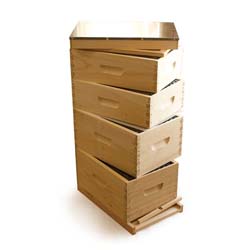Honey production can vary widely depending on the hive’s age, strength, location, and management. Here’s a general breakdown of what you can expect.
- First-Year Hive: 0–20 pounds, if any. Most energy goes into building comb and establishing the colony.
- Established Hive: 30–60 pounds are typical for a healthy, well-managed hive.
- Strong Hive in Ideal Conditions: 80–100+ pounds are possible with great forage, weather, and management.
These are general estimates and many factors affect honey yields. These include…
- Geographic Location: The longer peak bloom season states, such as California, Florida and Texas, typically see higher honey production.
- Weather: Weather has a dramatic impact on honey production. Drought or excessive rain can reduce nectar flow.
- Forage Availability: Bees in rural areas with diverse flowering plants will produce more than those in cities with limited forage. Foraging range for honeybees is ~3 miles.
- Hive Management: Effective swarm control and timely supering are essential—if your bees swarm, your honey harvest may go with them.
- Colony Strength: A strong population of foragers built up in early spring is key to maximizing the main nectar flow.
- Bee Genetics: Some breeds, like Italian, Carniolan, Russian, or Buckfast, differ in productivity, temperament, and how they handle local conditions. Many beekeepers develop preferences based on their experiences.
Did you know?? North Dakota is known for producing the most honey in the states. The environment, rural area with ideal native plants and less monoculture agriculture make it favorable for honeybees.
